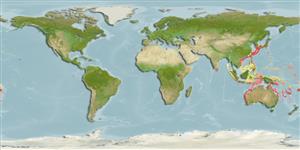Environment: milieu / climate zone / depth range / distribution range
Ökologie
seewasser benthopelagisch; tiefenbereich 128 - 200 m (Ref. 58018). Temperate
Western Indian Ocean. Western Pacific: recently recorded Japan and New Caledonia.
Size / Gewicht / Alter
Maturity: Lm ? range ? - ? cm
Max length : 23.0 cm TL Männchen/unbestimmt; (Ref. 9833)
Rückenflossenstacheln (insgesamt): 5 - 7; Rückenflossenweichstrahlen (insgesamt): 12-15; Afterflossenstacheln 4; Afterflossenweichstrahlen: 15 - 17. First infraorbital without spine on anterior end. Lateral line ends in caudal fin base. No fleshy disk on inner face of exposed area of scale. Anterior and posterior nostrils close together, their distance apart shorter than diameter of anterior nostril. Specimens from the Indian Ocean have more gill rakers than specimens from Japan.
A benthic or benthopelagic species trawled in 128-200 m depth.
Life cycle and mating behavior
Geschlechtsreife | Fortpflanzung | Ablaichen | Eier | Fecundity | Larven
Paxton, J.R., 1999. Berycidae. Alfonsinos. p. 2218-2220. In K.E. Carpenter and V.H. Niem (eds.) FAO species identification guide for fishery purposes. The living marine resources of the WCP. Vol. 4. Bony fishes part 2 (Mugilidae to Carangidae). FAO, Rome. (Ref. 9833)
IUCN Rote Liste Status (Ref. 130435)
Bedrohung für Menschen
Harmless
Nutzung durch Menschen
Fischereien: nicht kommerziell
Mehr Information
NamenSynonymeMetabolismusRäuberÖkotoxikologieFortpflanzungGeschlechtsreifeAblaichenSpawning aggregationFecundityEierEientwicklung
Alter/GrößeWachstumLänge-GewichtLänge-LängeLängenhäufigkeitenMorphometrieMorphologieLarvenLarven Pop.Dyn.RekrutierungDichteBRUVS
ReferenzenAquakulturAquakultur ProfilZuchtlinienGenetikElectrophoresesVererbbarkeitKrankheitenVerarbeitungNutrientsMass conversion
PartnerBilderStamps, Coins Misc.LauteCiguateraGeschwindigkeitSchwimmstilKiemenoberflächeOtolithsGehirngrößeSehfähigkeit
Tools
Zusatzinformationen
Download XML
Internet Quellen
Estimates based on models
Preferred temperature (Ref.
123201): 14.7 - 22, mean 19.2 °C (based on 40 cells).
Phylogenetic diversity index (Ref.
82804): PD
50 = 0.5088 [Uniqueness, from 0.5 = low to 2.0 = high].
Bayesian length-weight: a=0.01259 (0.00571 - 0.02773), b=3.04 (2.85 - 3.23), in cm total length, based on LWR estimates for this (Sub)family-body shape (Ref.
93245).
Trophic level (Ref.
69278): 3.8 ±0.6 se; based on size and trophs of closest relatives
Widerstandsfähigkeit (Ref.
120179): mittel, Verdopplung der Population dauert 1,4 - 4,4 Jahre. (Preliminary K or Fecundity.).
Fishing Vulnerability (Ref.
59153): Low vulnerability (13 of 100).
